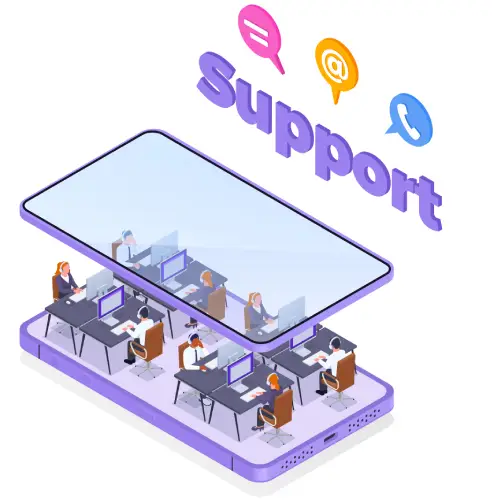In the dynamic and ever-evolving landscape of Information Technology (IT), organizations rely heavily on seamless and efficient IT operations to drive productivity and innovation. Within this intricate framework, the IT help desk plays a pivotal role in ensuring that users have a reliable and responsive resource to address their technical concerns. This article delves into the essence of IT help desk support, exploring its functions, significance, and evolving trends in the realm of technology.
Defining IT Help Desk Support
At its core, IT help desk support is a centralized service designed to provide assistance and resolutions to end-users encountering technical issues with their computer systems, software applications, or IT infrastructure.

The help desk serves as a frontline support system, acting as a point of contact between users and the broader IT department. Its primary goal is to swiftly address user queries, troubleshoot problems, and facilitate the smooth functioning of IT systems within an organization.
Key Functions of IT Help Desk Support
1. Incident Resolution
The primary responsibility of the IT help desk is to resolve incidents promptly. Incidents refer to any unexpected disruptions or issues that users may encounter while interacting with their computer systems. These can range from software glitches and hardware malfunctions to connectivity problems and user errors. The help desk team employs a systematic approach to diagnose, troubleshoot, and resolve these incidents, ensuring minimal disruption to users’ workflows.
2. Technical Support
Providing technical support is a fundamental aspect of IT help desk services. This involves assisting users with a diverse array of technical challenges, including software installations, configuration issues, and hardware malfunctions. Help desk professionals leverage their expertise to guide users through step-by-step solutions or escalate complex problems to specialized IT teams when necessary.
3. User Training and Guidance
In addition to incident resolution and technical support, the IT help desk also plays a crucial role in user training and guidance. As technology evolves, new software applications and tools are introduced, requiring users to adapt and acquire new skills. The help desk provides training resources, documentation, and personalized guidance to empower users to make the most of the available technology.
4. IT Asset Management
Effective management of IT assets is vital for organizational efficiency. The IT help desk is often responsible for tracking and managing IT assets, including computers, software licenses, and peripherals.

This includes inventory management, ensuring that assets are up to date, and assisting with the procurement and disposal of IT equipment.
5. Communication Hub
The IT help desk serves as a central communication hub between end-users and the broader IT department. It facilitates the flow of information, relaying important updates, system notifications, and maintenance schedules to users. Clear and timely communication is crucial for managing user expectations and fostering a positive relationship between IT and the rest of the organization.
Significance of IT Help Desk Support
1. Enhancing User Productivity
A responsive and effective IT help desk directly contributes to enhanced user productivity. By swiftly addressing technical issues, users can resume their work without prolonged disruptions, ensuring that the organization’s operations remain efficient and streamlined.
2. Minimizing Downtime
Downtime, whether caused by technical issues or system upgrades, can have significant repercussions for businesses. The IT help desk plays a key role in minimizing downtime by promptly resolving incidents and communicating proactively about scheduled maintenance, thus reducing the impact on users.
3. Improving User Satisfaction
User satisfaction is a critical metric for the success of IT services within an organization. A well-functioning help desk that provides timely and effective support contributes to a positive user experience, fostering a sense of confidence in the organization’s IT infrastructure.
4. Facilitating Innovation
By handling routine technical issues and providing ongoing support, the IT help desk enables users to focus on their core responsibilities and encourages a culture of innovation. Users are more likely to explore and leverage new technologies when they know that reliable support is available to address any challenges that may arise.
5. Contributing to IT Strategy
The insights gathered by the IT help desk, including the types of issues reported and user feedback, can be valuable for shaping the broader IT strategy. This information helps IT leaders identify recurring problems, assess the effectiveness of current solutions, and make informed decisions to enhance overall IT operations.
Evolving Trends in IT Help Desk Support
As technology continues to advance, the landscape of IT help desk support is also evolving. Several trends are shaping the future of IT support services:
1. Automation and AI Integration
Automation and artificial intelligence (AI) are increasingly being integrated into IT help desk operations. Chatbots, virtual assistants, and automated ticketing systems can handle routine tasks, allowing human support agents to focus on more complex issues. This not only improves efficiency but also provides users with faster responses.
2. Self-Service Portals
Self-service portals empower users to find solutions to common issues independently. These portals often include knowledge bases, FAQs, and step-by-step guides, reducing the volume of support tickets for routine problems. Users appreciate the autonomy and convenience of resolving issues on their own.
3. Remote Support
The rise of remote work has necessitated a shift in IT support toward remote assistance. Help desk professionals now use remote support tools to troubleshoot and resolve issues on users’ devices, regardless of their physical location. This trend aligns with the flexible work arrangements adopted by many organizations.
4. Proactive Monitoring and Predictive Analytics
Rather than waiting for users to report issues, proactive monitoring and predictive analytics are becoming integral to IT help desk strategies. By leveraging data and analytics, IT teams can anticipate potential problems, address them before they escalate, and implement preventive measures to enhance system reliability.
5. Multi-Channel Support
Users expect flexibility in how they seek support. IT help desks are increasingly adopting multi-channel support, including email, chat, phone, and even social media. This ensures that users can choose the communication channel that best suits their preferences and needs.
Conclusion
In the complex and fast-paced world of IT, the help desk stands as a crucial linchpin, bridging the gap between technology and end-users. Its multifaceted role encompasses incident resolution, technical support, user training, asset management, and communication facilitation. The significance of a well-functioning IT help desk extends beyond immediate problem-solving; it influences user satisfaction, organizational productivity, and the overall trajectory of IT strategy.
As organizations embrace emerging technologies and work models, the IT help desk continues to evolve, incorporating automation, self-service portals, remote support, and predictive analytics. By staying attuned to these trends and continually adapting to the changing IT landscape, help desks can position themselves as proactive enablers of innovation and reliable guardians of technological well-being within organizations. As we celebrate the one-year birthday of this article, it’s a reminder that the journey of IT help desk support is ongoing, marked by adaptation, evolution, and a commitment to delivering exceptional user experiences in the ever-evolving realm of technology.










